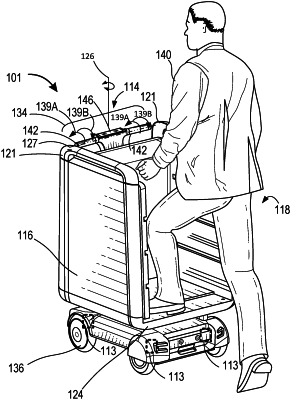| CPC B25J 11/008 (2013.01) [B25J 5/007 (2013.01); B25J 5/06 (2013.01); B25J 9/08 (2013.01); B25J 13/006 (2013.01); B62B 3/005 (2013.01); B62B 5/0026 (2013.01); B62K 7/04 (2013.01); G06F 21/32 (2013.01); A61G 5/04 (2013.01); B62B 5/0069 (2013.01); B62B 5/06 (2013.01); B62B 2203/70 (2013.01)] | 17 Claims |

|
1. A multi-use mobile robot comprising:
one or more wheels mechanically drivable by a wheel actuator to drive the multi-use robot;
a base platform comprising a telescoping internal frame configured to support a passenger in a first configuration and carry cargo in a second configuration; and
a robot controller comprising a memory for storing executable instructions, the robot controller configured to execute the executable instructions to:
transport the passenger in the first configuration; and
transport the cargo disposed on a cargo surface of the telescoping internal frame in the second configuration, wherein the cargo comprises protrusions disposed on opposing sides of the cargo, and wherein the protrusions are configured to be supported by a pair of payload surfaces disposed on opposing sidewall panels of the internal telescoping frame;
a conveyor mechanism disposed on a sidewall panel of the opposing sidewall panels,
wherein the robot controller is further configured to execute the executable instructions to:
actuate the conveyor mechanism;
rotate the conveyor mechanism; and
convey the cargo along the pair of payload surfaces such that the cargo changes position with respect to a back internal frame wall of the telescoping internal frame.
|